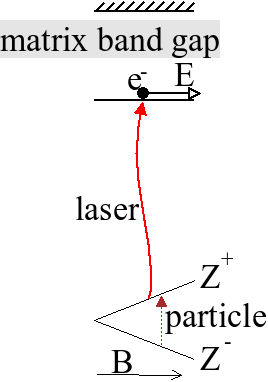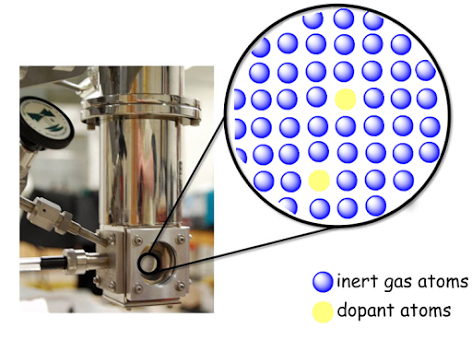AXIOMA MATRIX
AXIOMA MATRIX is a particle detector R&D proposal based on the matrix isolation technique (MIT) combined with laser spectroscopy and high sensitivity electrons detection. It makes part of the research activities conducted within the INFN group in Padova at LNL.
MIT was firstly introduced in the 50's by Pimenten and co-workers [1] for the systematic studies of free radicals and other unstable species by trapping these molecules in solid matrices at cryogenic temperatures. As the matrix is made of unreactive materials, diffusion processes are suppressed and only weak interaction between host and guest can take place. The dopant is then said to be isolated within the matrix and the guests atoms can be treated as free particles.
The devised scheme is based on the possibility to extract electrons through the matrix-vacuum interface and to efficiently detect them in vacuum, owing to the high charge gain and low dark count rate of microchannel plate or semiconductor detectors.
AXIOMA MATRIX is aimed at the direct investigation of dark matter candidates such as Axions and WIMPs.
In AXIOMA MATRIX, low energy threshold can be achieved in two ways:
- The first idea considers the direct ionization of the undoped matrix that follows an electron recoil process. In this configuration, the detector can be addressed to study energy release in the keV range. WIMPs related searches in a keV mass range can be indeed performed differently from the experiments based on noble liquid technology.
- The other scheme is instead based on alkali atoms doping. These guests atoms introduce sub-eV atomic energy levels inside the energy band gap and an intrinsic energy threshold Eth can be engineered in the order of hundreads of μeV . Eth is the Zeeman splitting of the ground state due to an external magnetic field B and it can be tuned to match a precise energy in the axionic dark mater resonant searches.
Matrix materials under investigations are solid methane, solid Neon and solid para-Hydrogen. In these materials, a free electron has in fact a greater energy with respect to the energy in vacuum, an so it can be extract if no impurities are also embedded into the crystal.

AXIOMA MATRIX apparatus is mainly constituted of a cryostat where the solid crystals are grown. An important part of the apparatus consists furthermore in the gas-purification set-up that is due to the necessity of grow high purity crystals.
The first part of the work is aimed at the characterization of matrix materials and study of the alkali dopants embedded into the crystals with spectroscopic techniques.

References:
- Edwin D. Becker and George C. Pimentel, Spectroscopic Studies of Reactive Molecules by the Matrix Isolation Method, The Journal of Chemical Physics 25, 224 (1956); doi: http://dx.doi.org/10.1063/1.1742860